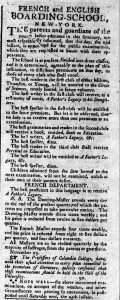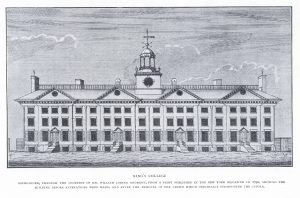A notice in the New-York Journal of November 23, 1786, notes that a number of young women participated in public examinations at Columbia College, vying for prizes for the best reader, best writer, best speller and best proficient in French. Women taking exams at Columbia in 1786? Yes, just months after its first Commencement since the American Revolutionary War, Columbia College hosted the public examinations of the students from the nearby French and English Boarding School.

In the spring of 1786, Eliza Harriot O’Connor started the French and English Boarding School near what is now Fulton Street. This was the first of O’Connor’s successful academies for young women. Public examinations, in which students would compete for prizes, were very much standard for the male academies and colleges. In fact, Columbia College would host public examinations quarterly, which were also advertised in the local newspapers for family and friends to attend. When the French and English Boarding School announced their first public examinations, so many tickets were requested that the School needed a larger space to host this event. According to the article in the paper, the professors of Columbia College “with their usual attention to every plan connected to the promotion of literature, politely consented that these examinations should be held in the Hall of the University.” [1] Not only that, but the Governess (or Head of School) told the papers that the professors “not only complied with the most cheerful liberality but also assisted laboriously in the course of this examination.” [2]
The French and English Board School examination accounts bring up two bits of Columbiana trivia. First, the articles mention the generosity of the professors of Columbia College. This special accommodation did not come from the President of the College because, when Columbia reopened after the Revolutionary War in 1784, there was no college president. Instead, the faculty took turns filling the presidential role. Every month, there was a different professor serving as acting president until William Samuel Johnson became president in November 1787.

Second, it wasn’t until 1883, almost a hundred years later, that women students first took exams as students at Columbia. The Collegiate Course for Women was Columbia’s first attempt to offer women (very limited) access to the undergraduate program. The women students needed to pass the same entrance examinations for Columbia College as the male students and they could enroll in the same courses as the male students. However, the women were not allowed to attend the lectures with the male students. The women would meet with the professors at the beginning of the semester, receive a copy of the syllabus and the required readings, and they could then study on their own for the rest of the semester to prepare for the examinations. Under these very challenging circumstances, Mary Parsons Hankey became the first woman to receive her undergraduate degree from Columbia College in 1887. From 1883 to 1889, the Collegiate Course for Women enrolled 99 students but awarded only 8 degrees. The Collegiate Course for Women was ended once Barnard College opened its doors in 1889.
[1] New-York Journal, November 23, 1786.
[2] New York Daily Advertiser, November 27, 1786.